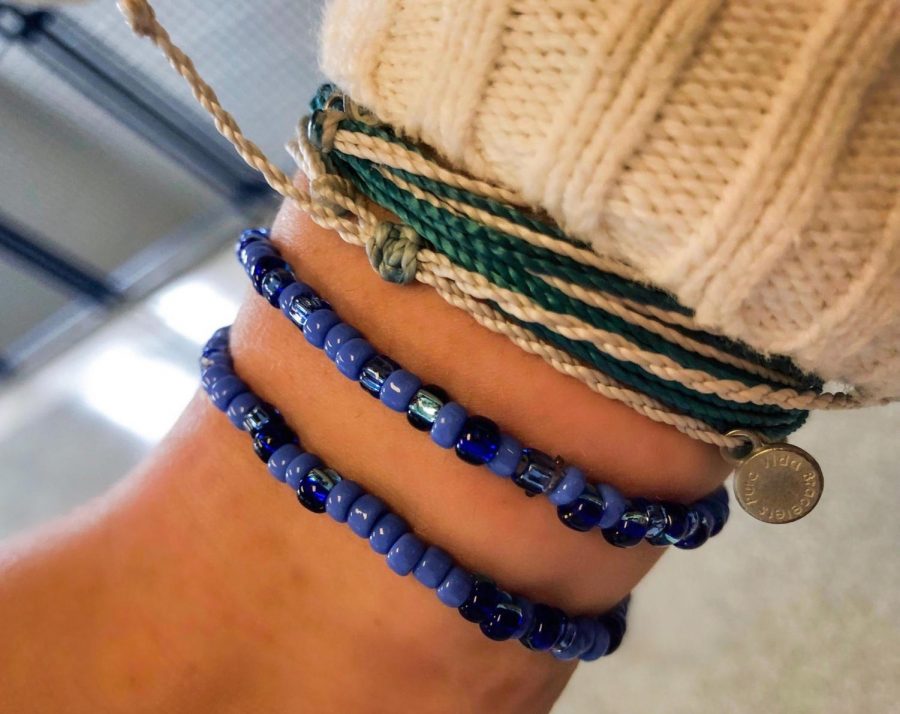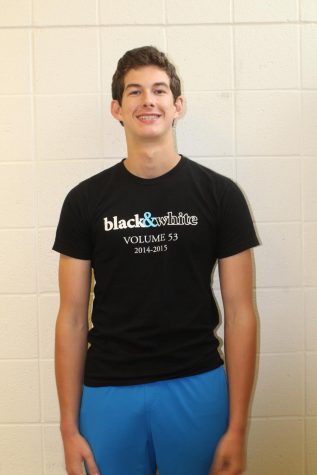Whitman parent Gil Rosen’s beading passion spreads kindness
Rosen makes beaded bracelets for boys varsity soccer team, sports fans
Senior Natan Rosen’s dad decided to make bracelets as a mindfulness practice. Since he started making them, he estimates he has made and given out—for free—10,000 beaded bracelets over the last four years.
January 31, 2019
When senior Natan Rosen scored the goal that tied the boys soccer state championship game Nov. 16, tiny blue beads went flying. His dad, Gil Rosen, had been making bracelets—hundreds of beads were attached to his hip in a small container—when his son scored, and he couldn’t help but jump with excitement. Most parents wouldn’t be making crafts in the biggest game of their child’s soccer career, but for Rosen, making bracelets is just part of his mission to “impact the world through kindness.”
Four years ago, Rosen was working in a hospice facility through the Jewish Social Service agency when he noticed a woman making bracelets to calm herself. He recognized the meditative power of beading: bracelet-making reminded him of his grandmother’s knitting. So he decided to start making bracelets himself. Since then, he estimates he has made and given out 10,000 beaded bracelets over the last four years.
He gives out bracelets to anyone—as long as they agree to “pay it forward” with their own acts of kindness, he said.
“I call them healing bracelets, and I’ve also given them out to lots of players and friends and sick friends in the hope that they get better,” Rosen said. “But I always tell them that these healing bracelets are not necessarily a healing for themselves, but are an invitation to heal other people.”
Rosen uses small beads to make the bracelets, and he uses blue beads because blue represents hope.
Rosen also used beading as a form of self-care after his brother took his own life five years ago. For him, making bracelets started as a mindfulness practice, but has evolved into “an introspective spiritual journey,” he said.
“I use beading as a kind of mindful meditation,” Rosen said. “That’s kind of how I deal with anxiety and depression. For me, it’s a very calming thing.”
At soccer games, he presented a challenge to students in the stands: pick up 18 pieces of trash and earn a bracelet in return.
“Trash is a big issue for me,” Rosen said. “I think as a society we are very negligent about the resources that we consume.”
For Natan, his dad’s passion spreads kindness.
“He’s doing something that embodies a positive message, so I’m happy with him doing it,” Natan said.
This year, Rosen made bracelets for all of the players on the boys varsity soccer team. Many of the players wore the small blue bracelets every day of the season and still wear them. Rosen calls these “family bracelets.”
Rosen wanted to create that sense of family among teammates to eliminate the hypercompetitiveness of youth sports, which he calls the “professionalization of youth soccer.”
“Most of us decided it was going to be a family bracelet because we feel like we’re a family,” defender Abe Hoogeveen said. “But it’s also a championship bracelet, so it can be whatever we want it to be.”
For Rosen, the soccer team was the perfect place to spread his message, and he’s glad his bracelets could bring the community closer.
Those who have received the bracelets have said they felt compelled to spread Rosen’s message of kindness.
“This bracelet has inspired me to go out of my way to help others whenever I can,” goalkeeper Sam Nordheimer said. “Knowing how many hours Gil spent beading these so that we could wear them reminds me that I need to give back.”
Rosen also gave bracelets to some of his son’s friends in the stands during games: sometimes they were a reward for cheering the loudest or most creatively; other times they were simply a token to spread kindness.
Rosen doesn’t follow up with his bracelet recipients to make sure they’ve done the acts of kindness they promised, and he doesn’t give long lectures about the bracelets’ meaning either.
“I think of myself as just trying to impart a little bit of love. Where that love goes, I have no idea. I’m curious, but I also think it’s nice that I don’t,” Rosen said. “It makes it a little more pure. It’s kind of like the butterfly effect, where you do some kind thing and you let it go.”
Mateo Gutierrez also contributed to this story.








